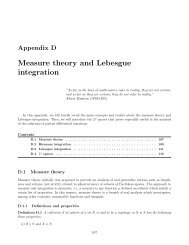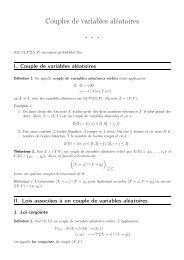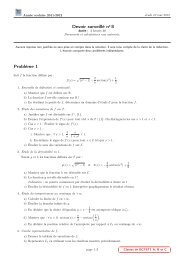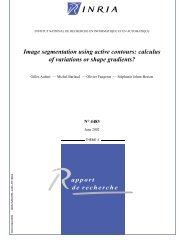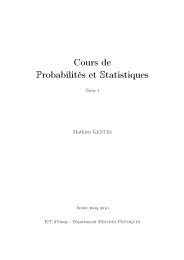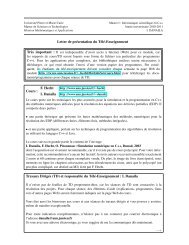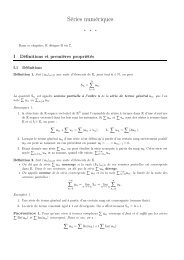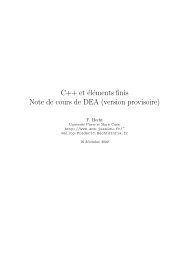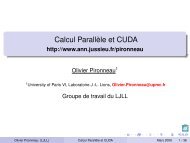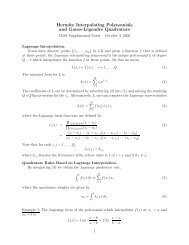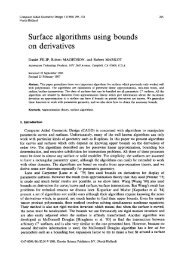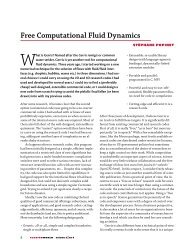Anisotropic Delaunay Mesh Adaptation for Unsteady Simulations
Anisotropic Delaunay Mesh Adaptation for Unsteady Simulations
Anisotropic Delaunay Mesh Adaptation for Unsteady Simulations
Create successful ePaper yourself
Turn your PDF publications into a flip-book with our unique Google optimized e-Paper software.
184 C. Dobrzynski and P. Frey<br />
Lemma 1. Let T i be an arbitrary triangulation and let p ∈ R d be a point enclosed<br />
in T i , p not being a vertex of T i . Then, a valid con<strong>for</strong>ming triangulation T i+1<br />
having p as vertex can be created using the <strong>Delaunay</strong> kernel, Theorem 1.<br />
The proof relies on the star-shaped character of the region C(p) with respect to<br />
point p [18]. This is only possible if the cavity is created incrementally from a<br />
seed tetrahedron (see above). Notice that due to this restriction, the resulting triangulation<br />
T i+1 may not be a <strong>Delaunay</strong> triangulation, although it is con<strong>for</strong>ming<br />
to finite elements requirements [10].<br />
Point insertion issues<br />
Defining the cavity C(p) ofapoint p requires identifying all simplices having<br />
acircumsphere that contains point p. The radius of the sphere circumscribed<br />
to asimplex K corresponds to the distance between any vertex p i of K and<br />
the circumcenter O of K: r K = d(p i ,O)=‖Op i ‖.The circumcenter O can be<br />
computed as the solution of alinear system of the <strong>for</strong>m:<br />
‖Op 1 ‖ = ‖Op i ‖ , ∀p i ∈ K , p i ≠ p 1 ,i= 2, . . . , d .<br />
Hence, given apoint p, an element K belongs to the cavity C(p) iff the following<br />
relation holds:<br />
α(p, K) = ‖Op‖<br />
r K<br />
< 1 ,<br />
where α(p, K) is the <strong>Delaunay</strong> measure of point p with respect to the simplex K.<br />
First,we haveto find the simplexor, in some peculiar cases, the set {K ∈ T h ,p∈<br />
K} of all simplices containing p the point to be inserted. Then, by incorporating<br />
all adjacent simplices K i such that α(p, K i ) < 1, the set C(p) is obtained. Each<br />
time a new simplex K i is added to C(p), the star-shapedness of this set is checked<br />
and the simplex iseventually removed if C(p) loses its property.<br />
In addition, to avoid the generation of badly-shaped elements like slivers,<br />
we introduced a minimal volume requirement: all new simplices obtained by<br />
connecting p to the external faces of C(p) must have a measure larger than a<br />
given lower bound: |K| >ε, with ε set to 1.10 −5 in the numerical experiments.<br />
This simple check has revealed especially and quite surprinsingly efficient in<br />
preventing the generation of most of the slivers, thus impacting favorably the<br />
optimization stage and the mesh quality histograms (cf. Section 4).<br />
3.2 <strong>Anisotropic</strong> <strong>Delaunay</strong> Kernel<br />
Asexpected, the extension to the anisotropic case consists of introducing a metric<br />
tensor, hence a symmetric positive definite matrix M p at each point p ∈ R d .This<br />
will allow us to consider the Euclidean norm of any vector in R d given the inner<br />
product 〈·, ·〉 M .Hence, all distance checks involved in the <strong>Delaunay</strong> measure will<br />
be replaced by length checks according to the given matrix M p ,namely:<br />
α Mp (p, K) = ‖Op‖ M P<br />
(r K ) Mp<br />
< 1 .



